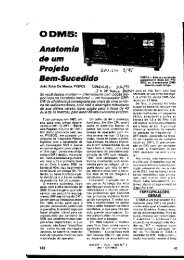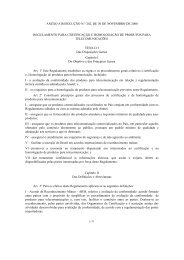A Software Defined Radio for the Masses, Part 3
A Software Defined Radio for the Masses, Part 3
A Software Defined Radio for the Masses, Part 3
You also want an ePaper? Increase the reach of your titles
YUMPU automatically turns print PDFs into web optimized ePapers that Google loves.
ate). Since we sample <strong>the</strong> RF signal<br />
in quadrature, <strong>the</strong> sampling rate is<br />
effectively doubled (44,100 Hz times<br />
two channels yields an 88,200-Hz effective<br />
sampling rate). This means<br />
that <strong>the</strong> output spectrum of <strong>the</strong> FFT<br />
will be twice that of a single sampled<br />
channel. In our case, <strong>the</strong> total output<br />
bandwidth of <strong>the</strong> FFT will be<br />
10.7666 Hz times 4096 or 44,100 Hz.<br />
Since most sound cards roll off near<br />
20 kHz, we are probably limited to a<br />
total bandwidth of approximately<br />
40 kHz.<br />
Fig 5 shows <strong>the</strong> DLL calls to <strong>the</strong><br />
Intel library <strong>for</strong> <strong>the</strong> FFT and subsequent<br />
conversion of <strong>the</strong> signal vectors<br />
from <strong>the</strong> Cartesian coordinate system<br />
to <strong>the</strong> Polar coordinate system. The<br />
nspzrFftNip routine takes <strong>the</strong> time<br />
domain RealIn() and ImagIn() vectors<br />
and converts <strong>the</strong>m into frequency domain<br />
RealOut() and ImagOut() vectors.<br />
The order of <strong>the</strong> FFT is computed<br />
in <strong>the</strong> routine that calculates <strong>the</strong> filter<br />
coefficients as will be discussed<br />
later. NSP_Forw is a constant that<br />
tells <strong>the</strong> routine to per<strong>for</strong>m <strong>the</strong> <strong>for</strong>ward<br />
FFT conversion.<br />
In <strong>the</strong> Cartesian system <strong>the</strong> signal<br />
is represented by <strong>the</strong> magnitudes of<br />
two vectors, one on <strong>the</strong> Real or x plane<br />
and one on <strong>the</strong> Imaginary or y plane.<br />
These vectors may be converted to a<br />
single vector with a magnitude (M)<br />
and a phase angle (P) in <strong>the</strong> polar system.<br />
Depending on <strong>the</strong> specific DSP<br />
algorithm we wish to per<strong>for</strong>m, one coordinate<br />
system or <strong>the</strong> o<strong>the</strong>r may be<br />
more efficient. I use <strong>the</strong> polar coordinate<br />
system <strong>for</strong> most of <strong>the</strong> signal processing<br />
in this example. The<br />
nspdbrCartToPolar routine converts<br />
<strong>the</strong> output of <strong>the</strong> FFT to a polar vector<br />
consisting of <strong>the</strong> magnitudes in M()<br />
and <strong>the</strong> phase values in P(). This function<br />
simultaneously per<strong>for</strong>ms Eqs 3<br />
and 4 in <strong>Part</strong> 1 of this article series.<br />
Offset Baseband IF Conversion<br />
to Zero Hertz<br />
My original software centered <strong>the</strong><br />
RF carrier frequency at bin 0 (0 Hz).<br />
With this implementation, one can<br />
display (and hear) <strong>the</strong> entire 44-kHz<br />
4 Nov/Dec 2002<br />
spectrum in real time. One of <strong>the</strong> problems<br />
encountered with direct-conversion<br />
or zero-IF receivers is that noise<br />
increases substantially near 0 Hz.<br />
This is caused by several mechanisms:<br />
1/f noise in <strong>the</strong> active components,<br />
60/120-Hz noise from <strong>the</strong> ac power<br />
lines, microphonic noise caused by mechanical<br />
vibration and local-oscillator<br />
phase noise. This can be a problem <strong>for</strong><br />
weak-signal work because most people<br />
tune CW signals <strong>for</strong> a 700-1000 Hz<br />
tone. Fortunately, much of this noise<br />
disappears above 1 kHz.<br />
Given that we have 44 kHz of spectrum<br />
to work with, we can offset <strong>the</strong><br />
digital IF to any frequency within <strong>the</strong><br />
FFT output range. It is simply a matter<br />
of deciding which FFT bin to des-<br />
IFShift = True ‘Force to True <strong>for</strong> <strong>the</strong> demo<br />
ignate as <strong>the</strong> carrier frequency and<br />
<strong>the</strong>n offsetting <strong>the</strong> local oscillator by<br />
<strong>the</strong> appropriate amount. We <strong>the</strong>n copy<br />
<strong>the</strong> respective bins <strong>for</strong> <strong>the</strong> desired<br />
sideband so that <strong>the</strong>y are located at 0<br />
Hz <strong>for</strong> subsequent processing. In <strong>the</strong><br />
PC SDR, I have chosen to use an offset<br />
IF of 11,025 Hz, which is one fourth<br />
of <strong>the</strong> sampling rate, as shown in<br />
Fig 6.<br />
Fig 7 provides <strong>the</strong> source code <strong>for</strong><br />
shifting <strong>the</strong> offset IF to 0 Hz. The carrier<br />
frequency of 11,025 Hz is shifted<br />
to bin 0 and <strong>the</strong> upper sideband is<br />
shifted to bins 1 through 1023. The<br />
lower sideband is shifted to bins 3072<br />
to 4094. The code allows <strong>the</strong> IF shift<br />
to be enabled or disabled, as is required<br />
<strong>for</strong> transmitting.<br />
If IFShift = True Then ‘Shift sidebands from 11.025KHz IF<br />
For S = 0 To 1023<br />
If USB Then<br />
M(S) = M(S + 1024) ‘Move upper sideband to 0Hz<br />
P(S) = P(S + 1024)<br />
Else<br />
M(S + 3072) = M(S + 1)‘Move lower sideband to 0Hz<br />
P(S + 3072) = P(S + 1)<br />
End If<br />
Next<br />
End If<br />
Figure 7 –Code <strong>for</strong> Down Conversion From Offset Baseband IF to 0Hz<br />
If SSB = True Then ‘SSB or CW Modes<br />
If USB = True Then<br />
For S = FFTBins To NFFT - 1 ‘Zero out lower sideband<br />
M(S) = 0<br />
Next<br />
Else<br />
For S = 0 To FFTBins - 1 ‘Zero out upper sideband<br />
M(S) = 0<br />
Next<br />
End If<br />
End If<br />
Figure 8 – Sideband Selection Code<br />
Fig 9—FFT fast-convolution-filtering block diagram. The filter impulse-response coefficients are first converted to <strong>the</strong> frequency<br />
domain using <strong>the</strong> FFT and stored <strong>for</strong> repeated use by <strong>the</strong> filter routine. Each signal block is trans<strong>for</strong>med by <strong>the</strong> FFT and subsequently<br />
multiplied by <strong>the</strong> filter frequency-response magnitudes. The resulting filtered signal is trans<strong>for</strong>med back into <strong>the</strong> time domain using <strong>the</strong><br />
inverse FFT. The Overlap/Add routine corrects <strong>the</strong> signal <strong>for</strong> circular convolution.











